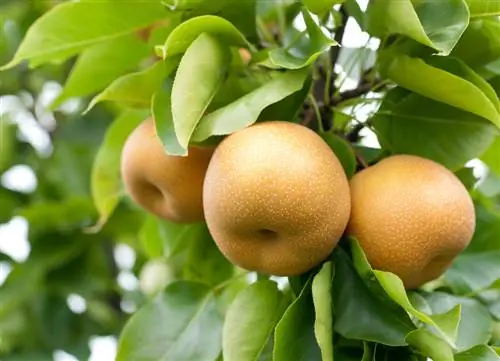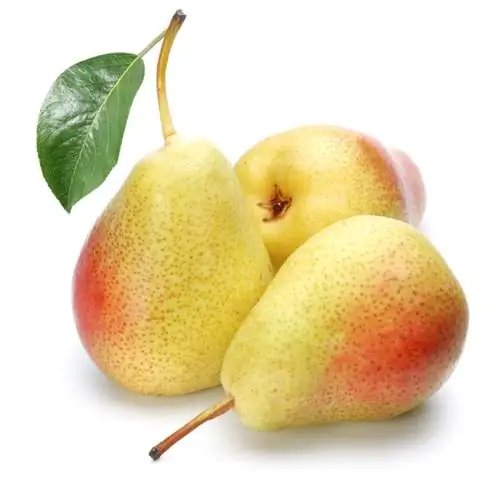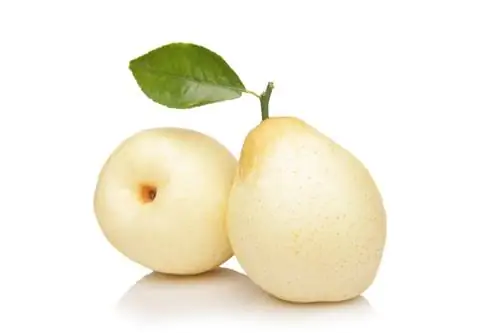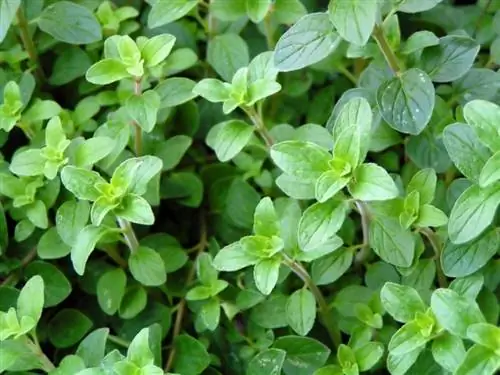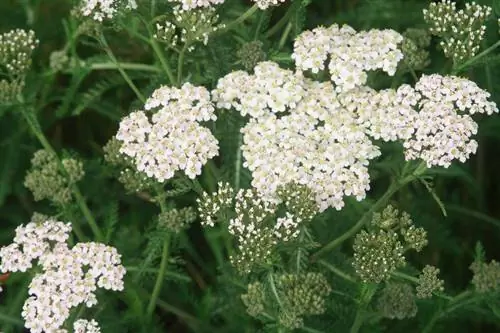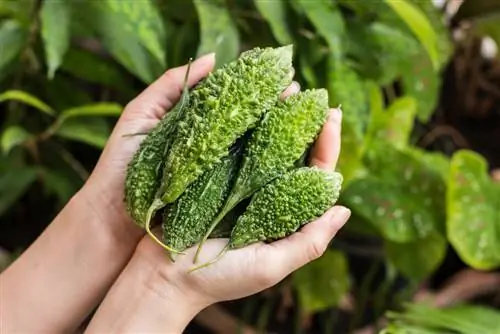- Author admin [email protected].
- Public 2023-12-16 16:46.
- Last modified 2025-06-01 06:02.
The Nashi pear is a popular newcomer on the fruit shelf. This raises culinary questions about consumption quality, taste and use. Hobby gardeners are primarily interested in how they can grow and harvest Nashis themselves. Compact answers, a profile with explanations and lots of green tips bring light into the darkness. Read a short portrait about the Nashi pear here. You can find out how to use nashis for culinary purposes and grow them yourself here.
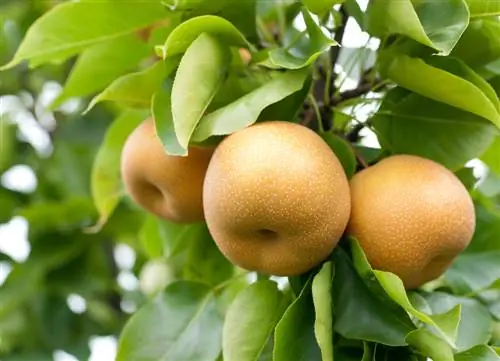
How to use and grow Nashi pears?
The Nashi pear, also known as apple pear, is primarily consumed raw or enjoyed as juice, fruit salad and shake. It can also be cooked as a compote, jam or as an accompaniment to game dishes. The hardy, Asian pear species can be grown in the hobby garden and harvested from September.
Nashi Pear Use - Overview, Questions & Answers
The Nashi pear is also aptly called apple pear. A thin, yellow-green peel covers the apple-shaped fruit. The juicy pulp is crunchy and grainy, like an apple, and surprises with a sweet and sour pear taste. Inside a Nashi pear there is a core like we know from local pears and apples. The following video proves why Nashis are on everyone's lips in this country.
Video: Nashis taste great for young and old - test meal at Detlef Römisch
How do you eat a nashi pear?
The sight of a Nashi pear makes fruit lovers' mouths water. A bite into the crunchy, juicy flesh will spark ideas for delicious variations. The following table gives an overview of how best to eat nashis raw and cooked:
| Raw | Pressed | Cooked |
|---|---|---|
| whole fruit as a snack | Juice | Compote/fruit puree |
| cut as fruit salad | with milk as a shake | Jam/Marmalade |
| Side dish for cheese/Parma ham | as an ingredient for ice cream | Side dish for game dishes |
Do you have to peel a Nashi pear?
You can peel a nashi pear, but you don't necessarily have to. In fact, the thin, yellowish-green or bronze-colored shell contains most of the nutrients, vitamins and minerals. Peeled nashis oxidize in the air within a few minutes and the now yellow-brown flesh spoils the appetite.
Are nashi pears suitable for compote?
Nashis are best eaten raw. Freshly harvested, the fruits go perfectly with fruit salads or add a refreshing touch to raw vegetable salads. When cooked, Nashi pears are also a tasty treat as a compote.
When is a Nashi pear ripe?
The harvest time for yellow Nashi varieties begins at the beginning of September. A fruit that is ready to harvest can be recognized by its light yellow skin with seductive sun cheeks. The bronze-colored varieties are ripe at the end of September/beginning of October. A careful pressure test removes any remaining doubts about whether it is ready for consumption. When the previously firm pulp gives way when pressed with your finger, the Nashi pear is ripe.
Is the Nashi pear he althy?
The Nashi pear is a he althy treat for the whole family. Valuable vitamin C, potassium, calcium, phosphorus and iron strengthen the immune system, promote bone development and metabolism. Because the apple pear contains little acid in the pulp, regular consumption has a calming effect on the stomach and intestines.
Profile
- Scientific name: Pyrus pyrifolia
- Genus: Pears (Pyrus)
- Origin: China, Japan
- Growth type: Tree
- Flower: white, cup-shaped
- Flowering period: April to May
- Fruit: apple-shaped, yellow-green, bronze-colored
- Taste: sweet pear aroma
- Calorific value: 32 calories/100 g
- Harvest time: September to October
- Maturity for enjoyment: light yellow with sunny cheeks
- Winter hardiness: hardy
Taste
The fruits of the original species Pyrus pyrifolia delight with their fine pear flavor. Fruit gardeners sometimes rave about a mild melon note. Premium varieties pamper the palate with a light champagne taste or are reminiscent of the aroma of local apple varieties.
Condensing value
Nashis are rich in he althy nutrients and low in calories. The following overview lists important values for 100 grams of Nashi pears:
- Calorific value: 32 kcal (134 kJ)
- Vitamin C: 2 mg
- Magnesium: 35 mg
- Bold: 0
- Carbohydrates: 8 g
- Fiber: 2 g
- Bread units: 0.7 g
Winter hardiness
In a sunny, warm location with a protected microclimate, the Nashi pear is reliably hardy in the bed. Planting the apple pear in loose, humus-rich, fresh, moist soil with trouble-free water drainage without the threat of waterlogging has a positive effect on winter hardiness.
Planting Nashi - tips for hobby gardeners
The Nashi pear has comparable requirements to local cultivated pears. In the right location there is nothing wrong with planting in a hobby garden. The following planting tips highlight all the important conditions:
Grow your own Nashi pear
With each core you hold the seeds for a Nashi tree in your hands. You can overcome the germination inhibition of Nashi seeds with stratification. How to grow a Nashi pear yourself:
- Place seeds in a bag with moist substrate in the refrigerator for 3 months
- Plant stratified Nashi kernels in a pot with coconut soil
- Sift seeds thinly with sand or coconut soil
- Press the seed soil and moisten it with a fine spray
- Cover seed container with transparent hood
- Moisten regularly in a warm, bright location
- Remove the hood when germination begins
Please use fresh seeds from the core of a Nashi origin species Pyrus pyrifolia. To grow a Nashi variety, we recommend purchasing certified seeds from specialist retailers.
Select location
Reserve a sunny, warm, wind-protected location in the garden for your Nashi pear. Modest soil requirements make the choice of location easy. A Nashi pear tree thrives vitally and productively in any normal garden soil. The soil should be rich in nutrients, loose humus and without the risk of waterlogging.
Plants
Planting time for a Nashi tree is in spring. Plant home-grown or ready-made Nashi pears in a spacious pit with a planting distance of two meters from each other or from the suitable pollinator. To protect against wind throw, drive a support post into the ground. Use hose ties to connect the trunk and posts below the crown and in the lower area. Tamp the earth firmly and coat the tree disc with rainwater.
Excursus
Nashi pear needs pollinator
A Nashi pear tree is generally not self-fertile. A second Nashi pear is required to fertilize the inflorescences. Local pear trees that bloom at the same time are also suitable as pollinators. These include well-known summer pear varieties such as 'Williams Christ' or 'Gute Luise'. If space is limited, a columnar summer pear also serves as a pollinator.
Nashi pear care - tips
The Nashi pear is undemanding when it comes to water and nutrient supply. Gardening challenges include propagation and pruning care. This is how you care for an apple pear in an exemplary manner:
Watering and fertilizing
It is easy to ensure uniform soil moisture without waterlogging through regular watering. Growth, abundance of flowers, yield and winter hardiness benefit from an organic nutrient supply. In April and June, work mature compost into the soil and water again. Nashi pears and pollinators are better protected against frost after adding potassium-rich comfrey manure in August.
Propagate
Anyone who is familiar with the refinement of fruit trees can propagate Nashi varieties themselves. Techniques such as copulation and oculation should be familiar to the hobby gardener. Premium varieties on the European market thrive on seedlings of native cultivated pears, such as 'Pyrodwarf', 'Kirchensaller Mostbirne' or 'Quitte'. Propagation is easier with cuttings from a true-root apple pear.
Cut Nashi pear
Expert pruning care makes a significant contribution to ensuring that a Nashi pear grows he althy and productive. For this aspect of care, please consult our detailed tutorials with detailed instructions and pictures for training, maintaining and fruiting apple trees and pear trees.
Diseases
With regard to the dreaded pear grid, the all-clear can be given at this point. Nashi pears have proven to be surprisingly resistant to fungal infection in European cultivation.
Popular varieties
The best-selling in Germany's nurseries is the original Nashi species Pyrus pyrifolia, followed by refined varieties that are ideal for hobby gardens:
- Hosui: early harvest from the end of August, bronze-colored, apple-shaped fruits for many uses.
- Nijiseiki: self-fertile, easy to care for, medium-sized, yellow-green fruits with a champagne flavor.
- Kosui: white flowers from the beginning of April, large fruits, yellow-brown to bronze-colored, ready to eat from the beginning of September.
- Komui: very robust and hardy, brown skin, white flesh with a sweet, aromatic taste.
FAQ
Can you preserve Nashi pears?
Nashi pears are ideal for preserving as a compote. To ensure that the valuable vitamins in the shell are not lost, it is best to proceed as follows: Peel 1 kg of Nashis and cut out the core. Boil the peel, core, 1 clove and 1 cinnamon stick in 350 ml of water for 10 minutes. Strain the broth and use it as cooking water for the diced Nashi pears. Cook for about 5 minutes with the addition of 150 g sugar and a pinch of vanilla and pour into clean preserving jars.
Process Nashi pear into juice. How does it work?
With a juicer you can make refreshing juice from nashis in no time. Use ripe fruits with juicy, soft flesh. Ideally, you should not peel the Nashi pears because the peel contains many he althy vitamins. Cut the washed fruits into manageable pieces and put them into the juicer. The fruit pieces are juiced at the push of a button. You enjoy a really he althy juice. By the way, Nashi juice is said to work wonders against hangovers.
Does every Nashi variety need an additional pollinator?
Nurseries and garden centers also have self-fertile Nashi varieties available for you. This includes the Asian apple pear 'Nijiseiki', which does not necessarily rely on neighboring Nashi varieties or pear trees as pollinators for pollination. However, the solitary Nijiseiki tree often suffers from sparse fruit coverage. An additional fertilizer is therefore always advantageous.
What recipes are Nashi pears suitable for?
Fruity Nashi pears are suitable for all recipes that list pears or apples in the ingredients. These include many fruity delicacies such as compote, fruit puree, jam, pear juice, apple juice, milkshakes, pear cake, apple pie or ice cream. You can transfer the quantities for local pear and apple varieties to Nashis without hesitation.
What should you consider when storing Nashi pears?
You can store ripe nashis at room temperature for up to two weeks. To prevent yellow-brown bruises, place the fruits next to each other and not on top of each other. Storage in the refrigerator is not recommended because the cool temperatures significantly affect the taste and aroma.

